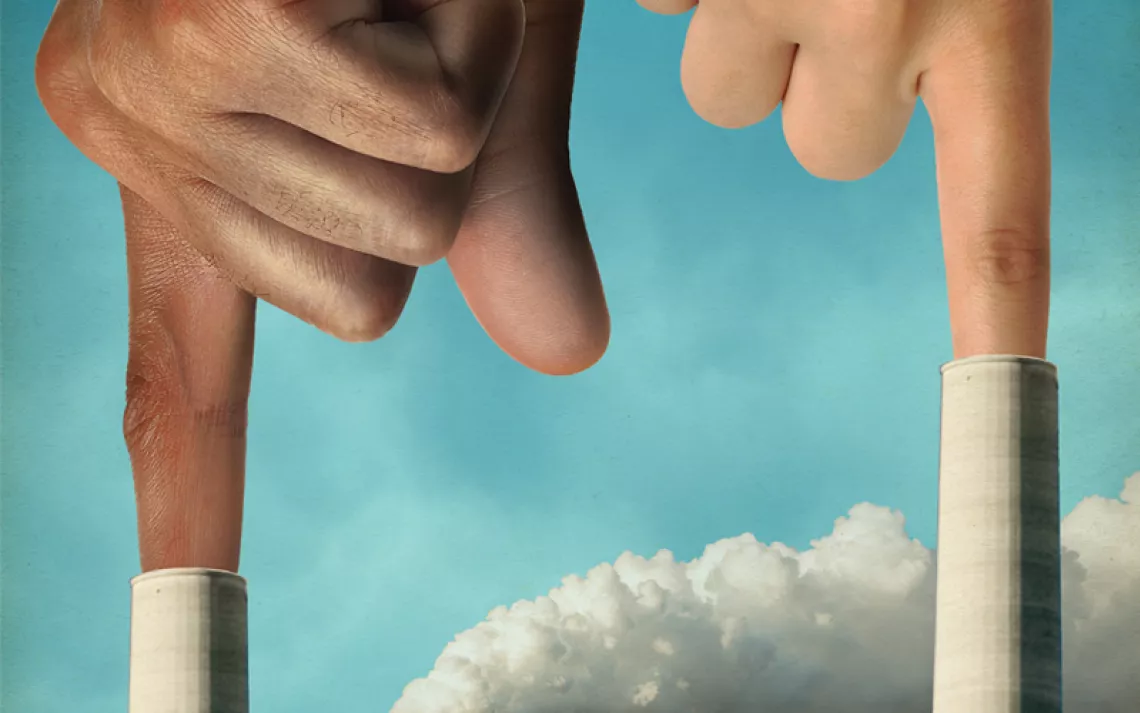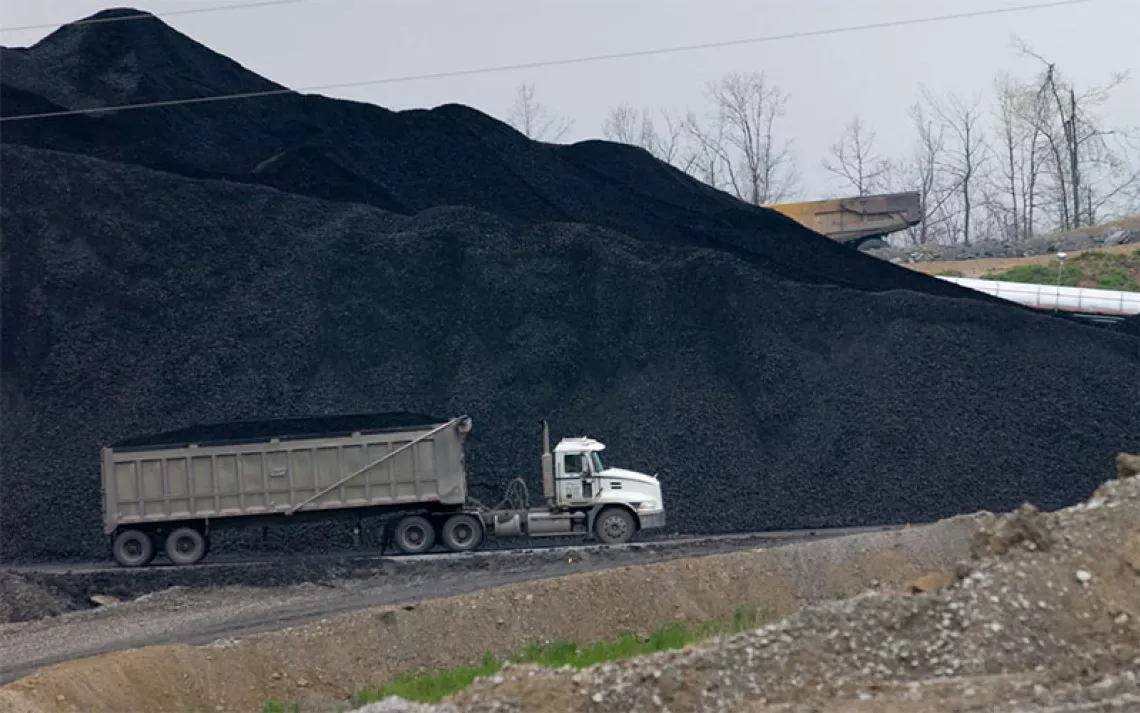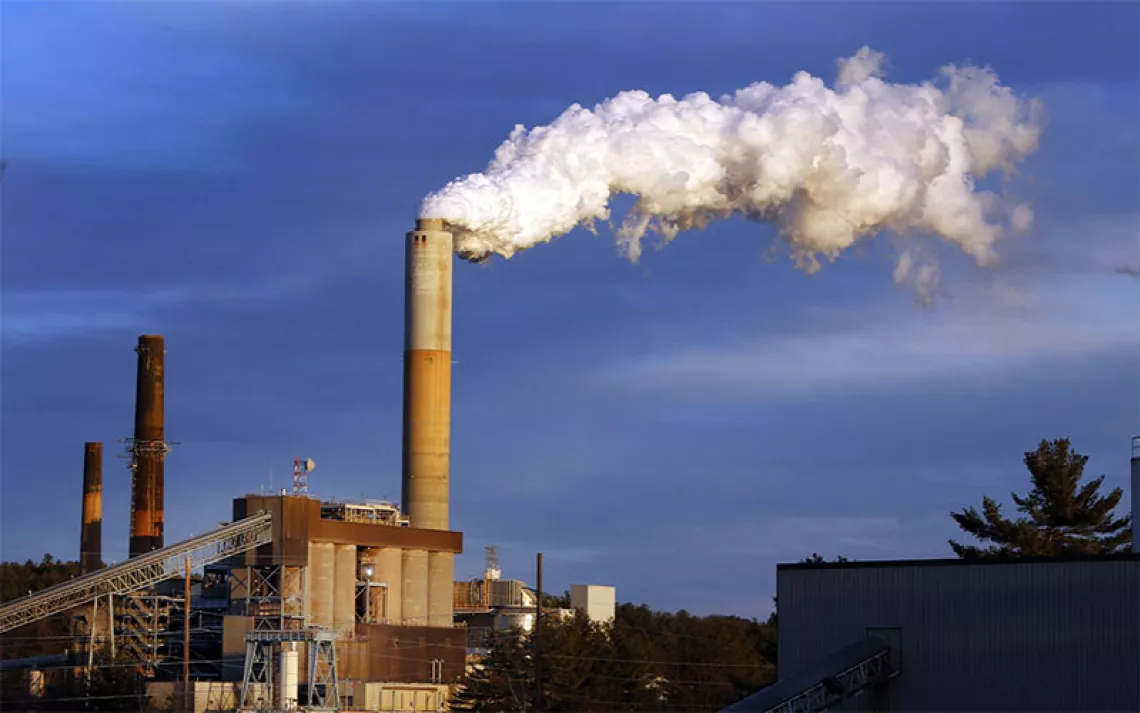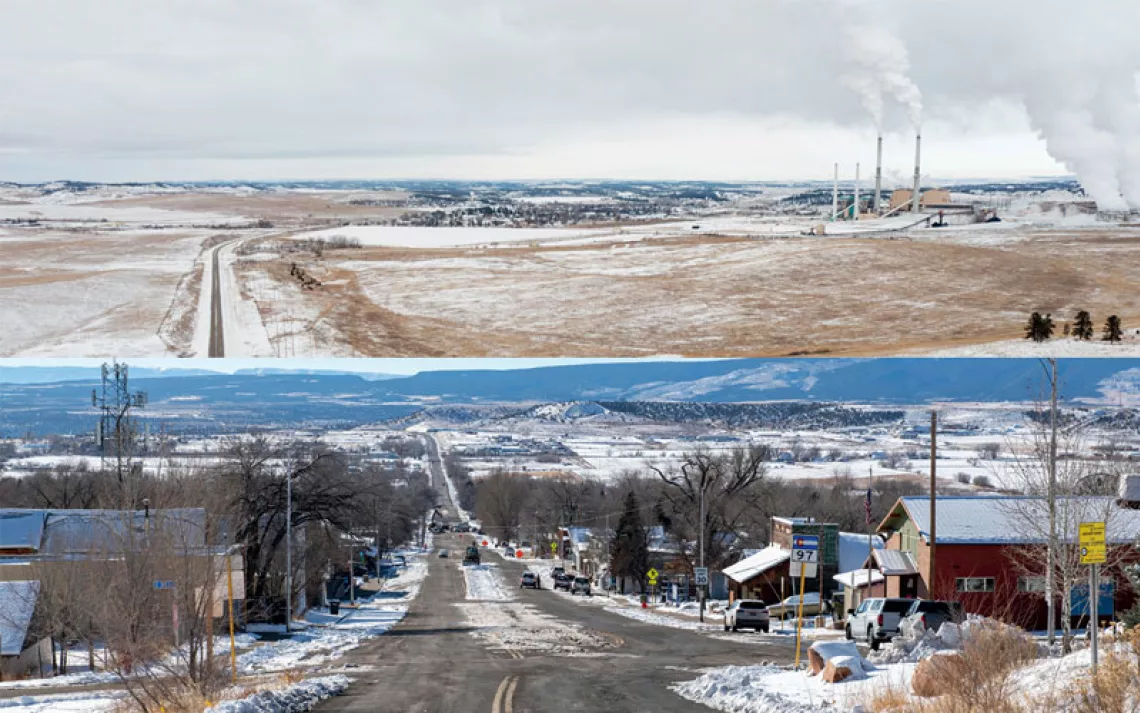Coal Dust Is Blowin’ in the Wind
That black stuff spilling off railcars is a threat to public health and waterways across the United States
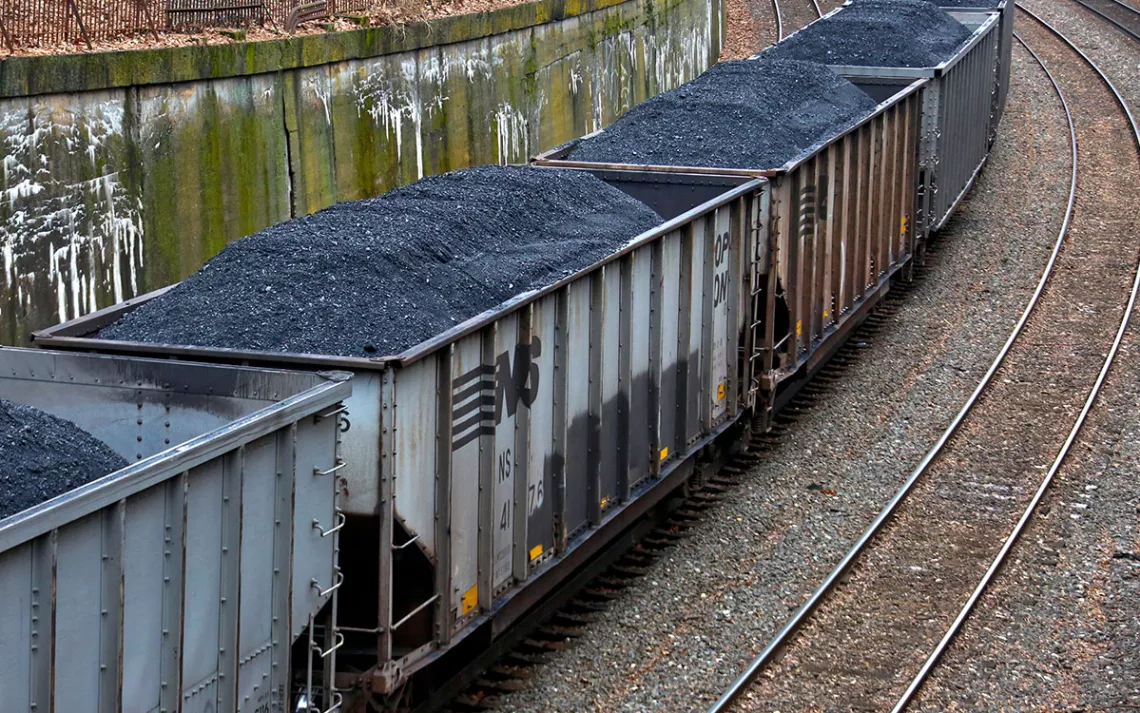
In this 2017 photo, a Norfolk Southern freight train hauling coal makes its way through downtown Pittsburgh. | Photo by Gene J. Puskar/AP
When Kim Williams moved to the Lambert’s Point neighborhood in coastal Norfolk, Virginia, in 1989, she immediately noticed the soot. The laundry hung on the clothesline became dusty. When she opened the windows in spring, black grime collected on the white sills. Running her hand along her home’s siding darkened her fingerprint. Her children’s outdoor toys were caked with the same dark-gray residue. After her two boys played in the yard, their knees looked like they’d wrestled in charcoal.
She’d stick the boys in the bathtub, and then she’d clean grime off the tub after they washed. Her eldest son, now 32, developed chronic sinus and ear infections as he grew up. Her younger son, now 23, had childhood asthma.
“I don’t know the connection, but they grew up in an old house and an attic filled with coal dust,” Williams said. Neither son lives in Norfolk anymore; her eldest son’s symptoms went away after he moved to Philadelphia, and her younger son eventually outgrew his asthma.
More than 30 years after Williams moved to Norfolk, coal dust remains a hazard in her neighborhood. The coal dust that to this day billows into Lambert’s Point comes from the Norfolk Southern rail line, train terminal, and shipyard. Once the largest coal-shipping terminal in the world, today the terminal has an annual capacity of 48 million tons. Lambert’s Point, a community of roughly 3,000 people, was founded along the Norfolk Southern line, after which the city of Norfolk is named. Community members, according to Virginia’s Department of Environmental Quality, have long expressed concerns about the potential health impacts from the coal dust, a pollutant long unregulated by local, state, or federal officials.
Now, in a petition to the Environmental Protection Agency scheduled to be filed today, grassroots groups around the country that are impacted by coal trains are calling on the agency to limit coal pollution discharged from train cars. The petitioners include Appalachian Voices, Columbia Riverkeeper, South Baltimore Community Land Trust, Puget Soundkeeper Alliance, Public Justice, and the Sierra Club.
“Our petition asks for coal to be treated like so many other goods that are required to be covered as they travel across the country, over rivers, and through communities,” Sierra Club attorney Aaron Isherwood said. “The EPA should take action and issue a national pollution discharge elimination system permit that requires coal cars to be covered. Covers would also help keep coal dust from blowing into the air in places all around the country where coal trains pass through residential communities—places where residents are currently forced to breathe dirty air because the coal trains are uncovered.”
Calling for regulations under the Clean Water Act, the filing states that the ongoing lack of oversight means “coal trains have become a significant source of water pollution across the United States.” When coal trains cross over waterways, the sweep of the wind or the movement of the cars causes daily discharges from the Pacific Northwest to the mid-Atlantic coast. At thousands of railway crossings, heavy metals and pollutants found in coal damage water quality and aquatic life, according to the petition.
While US coal production has been declining for over a decade and will continue to decline in 2023 and 2024, according to the Energy Information Administration, exports of both thermal and metallurgical coal will increase. And that means the amount of coal transported across the US will also increase.
“Each day, tens of thousands of uncovered railcars are loaded with coal and transported throughout the United States, crossing an untold number of streams, rivers, and waterways,” the petition reads. “For many communities, the sights and sounds of 120-railcar-long coal trains is common, as is the coal and coal dust pollution it brings with them.”
Now, the EPA has a decision to make. Will the agency regulate coal dust from railcars for the first time in US history? Or will communities continue to bear the burden of coal dust?
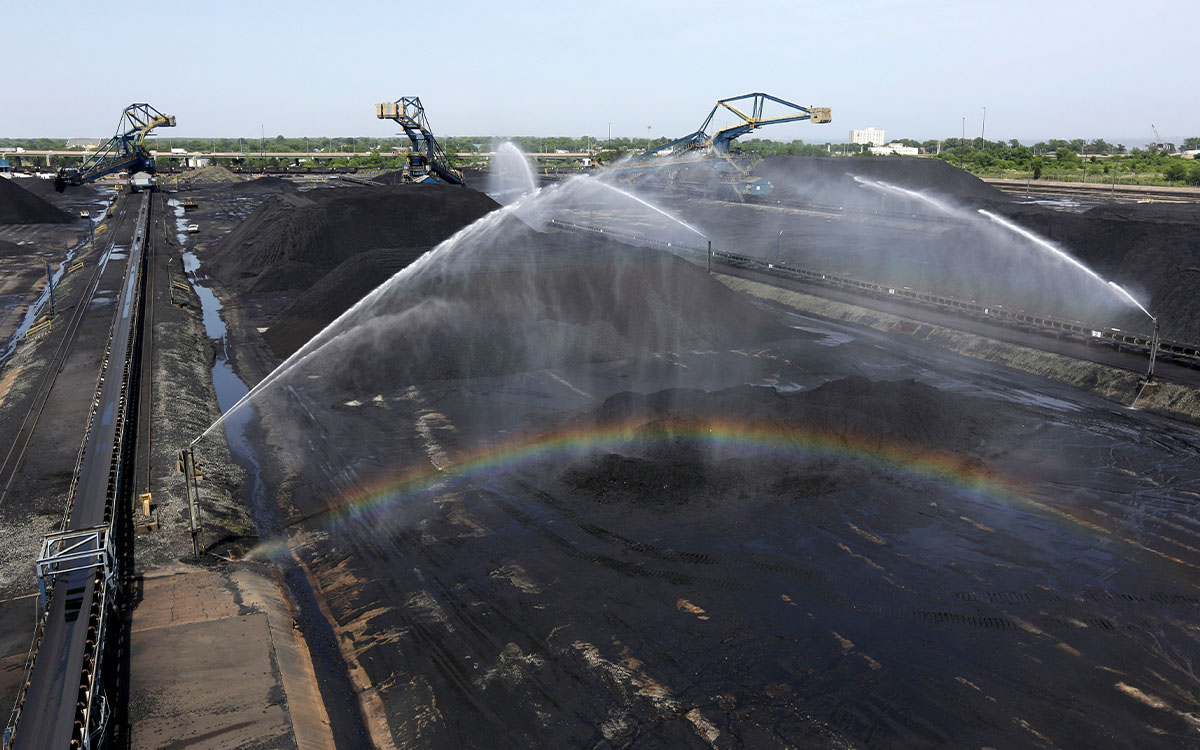
Photo by Patrick Semansky/AP
*
Many other bulk commodities that move by rail such as cement, sand, and sugar are transported in covered hoppers. In contrast, coal cars are open-top, and there are no requirements to cover the railcars. While train companies say covered railcars could cause coal to combust, uncovered cars allow coal particles to contaminate the air and water of communities along the rail line.
According to the petition, there is “no genuine dispute” that coal is lost from railcars. During testimony in 2011, BNSF Railway officials said each railcar loses at least 500 pounds of coal. For an average coal train of 120 railcars, at least 60,000 pounds of coal could be blown away into the environment each trip.
BNSF and Union Pacific have studied the issue in Wyoming’s Powder River Basin, the nation’s largest coal production site, and found coal was contaminating the ballast, or the gravel used to form the bed of a railroad track. BNSF proposed using a rail side emission monitoring system to measure coal dust blowing from the top of cars. If the shipper exceeded an emission standard, the mine or coal exporter would be subject to enforcement. In subsequent litigation brought by the Arkansas Electric Cooperative Corp., the Surface Transportation Board wrote that coal dust “is a particularly harmful contaminant of ballast that requires corrective action.”
While the Surface Transportation Board “acknowledged that coal dust poses a serious problem for railroad and safety operations,” it also found that mitigation “was not reasonable” given the “level of uncertainty and the available methods to control coal dust,” according to a 2011 press release.
The debate over coal discharge from the railway industry returned to the federal level in 2016, when a federal court ruled that railcars are subject to the Clean Water Act in a citizen lawsuit against BNSF for discharges of coal and coal dust from open-top railcars to nearby surface waters along rail lines that run from the Powder River Basin to Washington State. The parties settled that lawsuit while the trial was underway in 2015, with BNSF agreeing to clean up coal that was lost from its trains along the Columbia River and to study the use and implementation of coal car covers to stop the discharge of coal. That car cover study is ongoing.
Three years later, the Association of American Railroads, an industry group, asked the Surface Transportation Board to determine that this type of pollution couldn’t be regulated because of a provision in the Interstate Commerce Commission Termination Act that makes federal law trump any state’s regulations for uncovered railcars that frequently cross state lines.
The Surface Transportation Board did not rule on the petition but offered an advisory opinion that uncovered railcars—defined as “rolling stock” point sources of pollution under the Clean Water Act—couldn’t be regulated under the National Pollution Discharge Elimination System permit on a state-by-state basis because “it would likely result in a patchwork of differing regulations” that would interfere with the free flow of interstate commerce. But, the board added, a nationwide permit could fix that problem.
The petitioners say their proposed rule would create that fix. The petition asks the EPA to regulate open-car coal dust under the Clean Water Act’s National Pollutant Discharge Elimination System (or NPDES) permit, which governs discharge of coal contamination into navigable waters.
“Coal is the only rail-transported commodity that is knowingly allowed to be spilled or blown off railcars in transit,” said Dan Snyder, an attorney with Public Justice, a nonprofit law firm that helped prepare the petition. “The waterways and communities located in proximity to these rail lines have dealt with the environmental repercussions for decades. Congress clearly intended the Clean Water Act to apply to open-top railcars, and it’s far past time for EPA to close this train-sized loophole and require railroad operators to take uniform measures to control and limit discharges.”
*
Dan Jaffe, a physical sciences professor at the University of Washington, Bothell, began studying coal dust from trains in 2014 after four new coal terminals were proposed in Washington and Oregon to export coal from Montana and Wyoming. He collected data on particulate matter, carbon dioxide, and diesel smoke from train cars passing through the Columbia River Gorge.
“They had very visible, nasty coal dust plumes,” Jaffe said of “super-dusters,” trains that caused visible dust plumes associated with high particulate matter concentrations. Out of 367 train events across two months, at least four were super-dusters. Nearly all open-top trains released some amount of coal dust.
Jaffe’s research was considered in the environmental impact statements for the terminals, and all four were eventually rejected. Jaffe said when it comes to coal trains, “there’s basically no standards for them.” Currently, the most common technique to keep coal dust down is to spray surfactant, which Jaffe described as similar to hair spray.
Data collected by scientists like Jaffe has enhanced the scientific understanding about the impacts of coal dust pollution. Beginning in 2019, Matt Hepler, an environmental scientist at the regional nonprofit Appalachian Voices, and Dan Firth, a retired analytical chemist who volunteers and consults for environmental organizations, began taking a canoe onto the Clinch River in southwest Virginia to collect coal samples.
“We were focused on demonstrating coal dust is emitted from trains,” Firth told Sierra. “Coal dust doesn’t just fall on rocks obviously, but everywhere, in rivers, and washes off of rocks into rivers, so there’s evidence that coal can have impacts on the life in the river through physical means.”
The first samplings took place in October, and the trees were just starting to turn along one of the most biologically diverse river systems in the world. For years, bits of dust and palm-size chunks of coal had fallen from open-top cars crossing the railway bridge in Artrip, Virginia. The pair of researchers found flat boulders near the rail crossing and swept the dust particles with paint brushes into ziplock bags that they then delivered to a lab for analysis. Across eight sampling events, dust continued to reappear on the same rocks at the same site. The results of the two-year study showed that all collected samples contained bituminous coal.
“The dust just doesn’t go into the river, but the [rail] tracks go through towns and communities, depositing coal dust in those communities as well,” Hepler said. “While the most visible impacts are on Lambert’s Point, it does impact communities throughout the entire railroad.”
Janet Johnson, the co-coordinator of the Sunflower Alliance, a fossil fuel resistance group in Richmond, California, knows this well. Her group worked to pass an ordinance in Contra Costa County to sunset the transportation of export coal from Utah to Richmond’s Levin Terminal. Under a settlement, the transportation of coal to and from the terminal will end in 2026.
“We want to stop having coal come through our community,” Johnson said. “If the EPA regulates these open-top railcars, maybe they [the rail industry] will slow it down a little bit.”
*
Last August, a video posted on Norfolk’s Nextdoor page showed a plume of black dust billowing from the coal pier. The person who posted the video, Clair Berube, wrote that the video was filmed around noon, when she was driving down Powhatan Road and saw the coal dust arising from train cars.
“It looked as if someone had a huge blower and was just blowing black soot into the air,” Berube wrote. According to the post, a Norfolk city inspector said the company was cleaning the train tracks. “They’ve always done this. Well I’m sorry, but this is not OK. I need to complain to someone—we all need to complain.”
Akshaya Jha, an assistant professor of economics and public policy at Carnegie Mellon University, found that concentrations of fine particulate matter increased within 25 miles of coal plants stockpiling coal. “There’s a lot of evidence that it [fine particulate matter from coal dust] leads to cardiovascular and respiratory conditions like asthma and COPD and ultimately premature mortality from those types of conditions,” Jha said.
His study showed that a 10 percent increase in fine particulate matter known as PM 2.5 caused about a 1 percent increase in adult mortality rates and a more than 3 percent increase in infant mortality rates. Jha said the 2018 study likely underestimated the amount of coal dust emitted during rail transport because coal trains are moving at speeds greater than any transport that occurs at a power plant site.
Carl Poole lives about a 10-minute walk from Lambert’s Point, where he used to work security at the city water treatment plant adjacent to the railyard. At work, he saw coal cars all day long, soot billowing off the top.
“We have written them [Norfolk Southern] letters, we have Christmas caroled in front of their headquarters, we’ve asked for calls, meetings. I think the attitude from Norfolk Southern on a whole is indifference,” said Poole, who is now the Norfolk campaign coordinator for the New Virginia Majority, a statewide nonprofit working on economic and housing justice. “Covering their coal cars is something that we’re very interested in seeing get done.”
But he said getting the city or state to force Norfolk Southern to act had been difficult without data proving the amount of coal dust coming from the train line and terminal. In 2020, the Virginia DEQ began the Tidewater Air Monitoring Evaluation Project, the result of an EPA grant to collect data on pollution levels in Lambert’s Point. But Poole expressed frustration at the pace of the project, which he expects won’t begin monitoring until 2024. (The Virginia DEQ declined to comment on the ongoing project.)
“When you announce a study to folks, people expect it to happen immediately,” he said. People in the neighborhood see the physical evidence of accumulating dust around them all the time, said Poole, from black cobwebs on their front porches to dust on the windows to respiratory illnesses like asthma. He’s hoping if the EPA steps in, limiting coal dust pollution will gain new momentum in a community that has lived in the haze of the problem for decades.
 The Magazine of The Sierra Club
The Magazine of The Sierra Club
